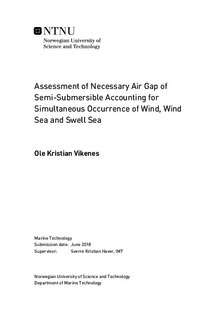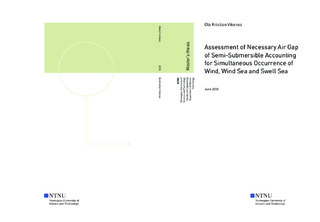| dc.description.abstract | The objective of this thesis is to estimate the necessary air gap of a semi-submersible in the Northern North Sea accounting for simultaneous occurrence of wind, wind sea and swell sea. This is done by performing a linear analysis following the simplified procedure for calculating air gap as found in DNVGL-OTG-13. The non-linearities are accounted for by applying an asymmetry factor of 1.2 in the analysis. Long term estimates for the ULS and ALS air gap are predicted using the all sea state approach (ASS) and the peak-over-threshold method (POT).
ASS considers the contributions to the extreme values from all observed sea states. Hence, the long term analysis is performed by combining the short term variability of the 3-hour maximum response described conditionally on all possible sea states with the long term joint distribution of the significant wave height and the spectral peak period. Since the traditional all sea state approach (TASS) is highly time-consuming for more complex response problems, a modified version of the all sea state approach (MASS) is proposed as an equally accurate alternative to the traditional approach. Similar to the POT approach, the modified version only considers events above a set threshold for the most important weather characteristic, the significant wave height. However, each sea state above the threshold is considered separately to follow the methodology of the TASS approach.
POT considers the storms above a selected threshold in the long term analysis. The extreme values are found from the established long term distribution of the largest response within an arbitrary storm. Non-observed events are accounted for by merging the conditional distribution of the largest response given the most probable largest response with the long term distribution of the most probable largest response. Inverse First Order Reliability Method (IFORM) is used to create response contours, where the maximum along the contours is taken as the q-probability response. This methodology is also proposed as a way of accounting for non-observed events for the MASS approach.
Several cases for the wave conditions are investigated: combined sea, total sea, wind sea, asymmetry factor = 1.2 and 1.3, JONSWAP and Torsethaugen wave spectrum. Torsethaugen gives more conservative results than JONSWAP for the air gap problem. Combined sea, total sea and wind sea give the same results, which suggests that the swell contribution can be neglected in the analysis for the air gap problem.
The platform considered in the thesis is found to have a negative air gap in both ULS and ALS for the most critical point under the platform. Hence, the platform must be designed to withstand horizontal wave loads in deck. The MASS approach gives more conservative results than the POT approach, because statistical independence between adjacent sea states is assumed for the MASS approach. | |

